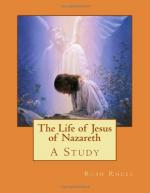13. On the sources outside the gospels see Anthony, Introduction to the Life of Jesus, 19-108; KeimJN I. 12-59; BeysLJ I. 59-72; GilbertLJ 74-78; Knowling, Witness of the Epistles; Stevens, Pauline Theol. 204-208; Sabatier, Apostle Paul, 76-85. On Josephus as a source see also SchuererJPTX I. ii. 143-149; RevilleJN I. 272-280. On the individual gospels see Burton, The Purpose and Plan of the Four Gospels (Univ. Chic. Press, 1900); Bruce, With Open Face, 1-61; Weiss, Introduction to N.T., II. 239-386; Juelicher, Einleitung i. d. NT, 189-207. On Matthew, Burton Bib. Wld. I. 1898, 37-44, 91-101; on Mark, Swete, Comm. on Mark, ix-lxxxix; on Luke, Plummer, Comm. on Luke, xi-lxx; Mathews, Bib. Wld. 1895, I. 336-342, 448-455; on John, Burton, Bib. Wld. 1899, I. 16-41, 102-105; Westcott, Comm. on John, v-lxxvii; Rhees in Abbott’s The Bible as Literature, 281-297. On the synoptic question see Sanday SBD^2, 1217-1243, and Expositor, Feb.-June, 1891; Woods, Studia Biblica, II. 59-104; Salmon, Introduction^7, 99-151, 570-581; Stanton in HastBD II. 234-243; Juelicher, Einl. 207-227. A. Wright, Composition of the Four Gospels (1890) and Some NT Problems (1898), defends the oral tradition theory in a modified form. On possible dislocations in John see Spitta, Urchristentum, I. 157-204; Bacon, Jour. Bib. Lit. 1894, 64-76; Burton, Bib. Wld. 1899, I. 27-35. For the history of opinion see specially H. J. Holtzmann, Einl.^3 340-375. On the Johannine question see Sanday, Expositor, Nov. 1891-May 1892; Schuerer, Cont. Rev. Sept. 1891; Watkins SBD^2 1739-1764; Burton, Bib. Wld. 1899, I. 16-41; Reynolds in HastBD II. 694-722; Zahn, Einl. II. 445-564 (defends Johannine authorship); Juelicher, Einl. 238-250 (rejects Johannine authorship). For the history of opinion see Watkins, Bampton Lecture for 1890; Holtzmann, Einl.^3 433-438. P. Ewald, Hauptproblem der evang. Frage, argues the authenticity of the fourth gospel from the one-sidedness of the synoptic story. See also Jour. Bib. Lit. 1898, I. 87-102.
14. Reville proposes to reconstruct Jos. Ant. xviii. 3. 3 thus: “’At that time appeared Jesus, a wise man, who did astonishing things. That is why a good number of Jews and also of Greeks attached themselves to him.’ Then follows some phrase probably signifying that these adherents had committed the error of proclaiming him Christ, and then ’denounced by the leading men of the nation, this Jesus was condemned by Pilate to die on the cross. But those who had loved him before persevered in their sentiment, and still to-day there exists a class of people who take from him their name Christians.’”
15. On the testimony of Papias (Euseb. Ch. Hist. iii. 39. 4) see Lightfoot, Cont. Rev. 1875, II. 379 ff., and McGiffert’s notes in his Eusebius, 170 ff.




